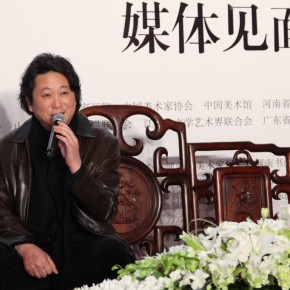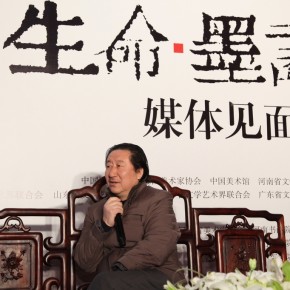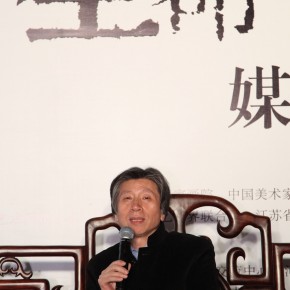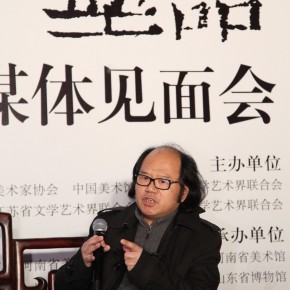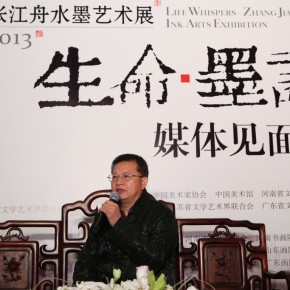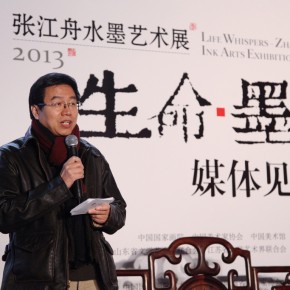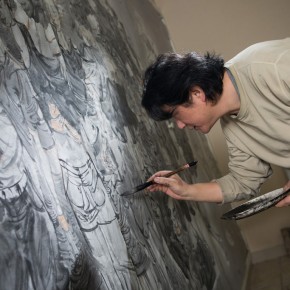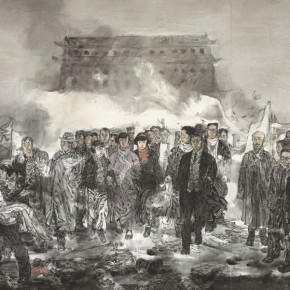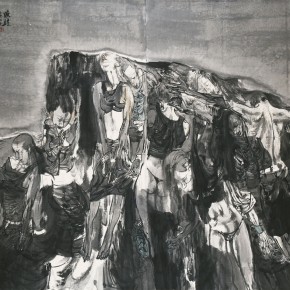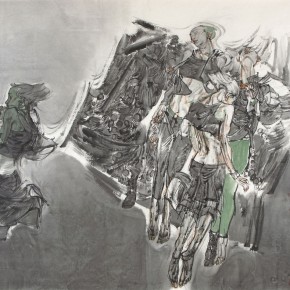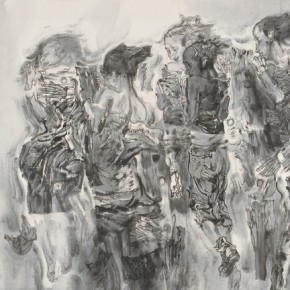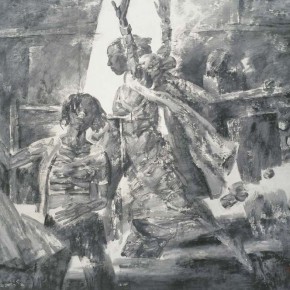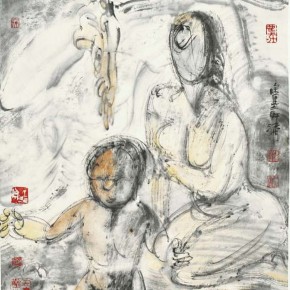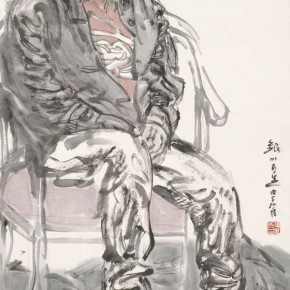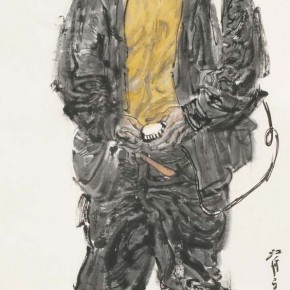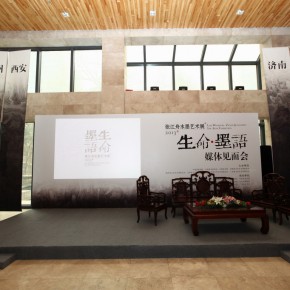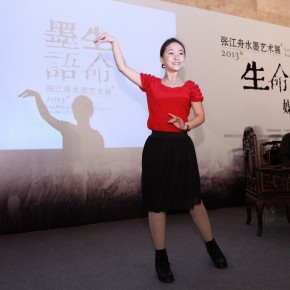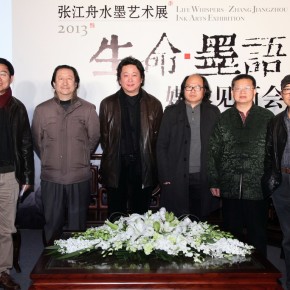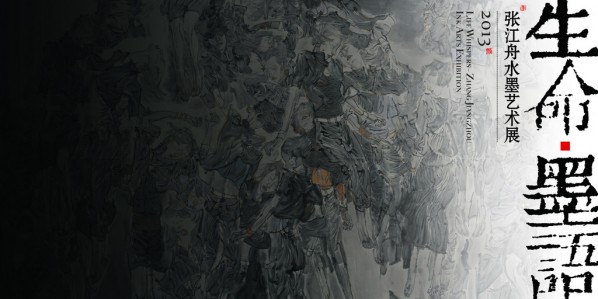
The media briefing for the tour exhibition “Life Whispers: Zhang Jiangzhou Ink Arts Exhibition” was held at the China National Academy of Painting, on March 19, 2013. It was jointly hosted by the China National Academy of Painting, Chinese Artists Association, National Art Museum of China, Henan Provincial Federation of Literary and Artistic, Shaanxi Provincial Federation of Literary and Artistic, Shandong Provincial Federation of Literary and Artistic, Jiangsu Provincial Federation of Literary and Artistic, Guangdong Provincial Federation of Literary and Artistic, etc., jointly organized by Art Exchange Center of the China National Academy of Painting, Henan Provincial Artists Association, Henan Institute of Painting and Calligraphy, Henan Art Museum, Shaanxi Provincial Artists Association, Shaanxi Provincial Academy of Chinese Painting, Shaanxi Province Art Museum, Shandong Provincial Artists Association, Shandong Institute of Painting, Shandong Museum, Jiangsu Provincial Artists Association, Jiangsu Traditional Chinese Painting Institute, Jiangsu Provincial Art Museum, Guangdong Provincial Artists Association, Guangdong Institute of Painting, and the Guangdong Museum of Art.
Held on the first floor of the exchange center at 15:00, the media briefing was presided over by Wang Luxiang, the guests present included: Yang Xiaoyang and Zhang Xiaoling, President and Vice President of the China National Academy of Painting, Fan Di’an, Director of the National Art Museum of China, painter Liang Zhanyan, Liao Zhi, an amputee dancer from the Wenchuan earthquake, and the painter Zhang Jiangzhou, as well as hundreds of professionals from the circles of media and art.
Zhang Jiangzhou initially shared the intention and the composition of the works in this exhibition with the audience. As a respective of contemporary Chinese Painting, noted for his fruitful creative achievement and active academic exploration, Zhang Jiangzhou’s “Mourning: the Memories of 2008” series of works, inspired by the Wenchuan Earthquake on May 12, care for people suffering the sudden death of relatives and the inquiry of the final meaning of life, which caused great repercussions in society as a whole.
“Life Whispers: Zhang JIangzhou Ink Arts Exhibition” will feature more than 40 pieces of paintings on the basic spiritual theme of “mourning”, since the creation of “Mourning: the Memories of 2008”, and most of the works are large-scaled figure paintings of ink and wash, as large as 200 x 200 cm. Looking back on this creative process, Zhang emotionally said, “It should be said that these works are the thoughts of value, inspired by the Wenchuan earthquake.” He continued the creative intention of the “Mourning”, deleting both the scenes of disaster and directly rendering symbols, and the desire to create a surreal space that was devoid of heaven and earth that left nothing except for life, dying, or blooming, or the unyielding struggle, to express his personal thinking of the final meaning of life. He was in a fine situation to create over the past years, which was a concentrated flare-up in his career, and he hoped that, he could exchange ideas, with the public and the community of collision and resonance, through such a serious academic exhibition, so that people could pay more attention to life, respect life, and care for life.
As Zhang’s leadership and old friend of many years, Yang Xiaoyang, President of China National Art Academy of Painting, talked about real stories of his missing comrades and the wars in the past, with a brief analysis of his works. Fan Di’an also reviewed his paintings, “There’s no doubt that there are unique masterpieces in the field of figure painting of ink and wash, the real thinking of the artist, a group of cultural codes on the combinations of the color of the time and personal style, and secular significance and universal value, with possession and by presenting his vast vision and belief of the concern of the country, a huge progressive energy for a better life.
Followed on by Liao Zhi, an amputee dancer from the Wenchuan earthquake, she talked about her personal experiences of the earthquake. She said she was not the character of his paintings, and they didn’t know each other. Not until she saw the works did she find a similar experience with the character of his paintings. She had no idea about that an artist was still painting the victims of the earthquake, after a lapse of five years, she was moved and admitted that, although she did not understand painting, she was able to read his works of real emotion, and the exhibition was of a profound meaning. Recalling the natural disaster in 2008, that evoked the compassion of the present audience. Subsequently, she danced on the stage, offering a visual feast, expression of her indomitable will and belief. The guests present were all touched by her performance.
After the dance, mediator Wang Luxiang, together with Zhang Jiangzhou, had a spectacular cross-border dialogue with the guests present, including Yang Xiaoyang, Zhang Xiaoling, Fan Di’an, and Liang Zhanyan.
Yang Xiaoyang said at the interview: “As the vice president of the China National Academy of Painting, Zhang Jiangzhou is busy with his administrative work, apart from his whole-hearted creation, which is a cultural mission, cultural responsibility and conscious persistence of an artist, in the current impetuous community, the time of fast-food “culture” and fragmentation, it’s admirable for an artist to spend five years searching and repeatedly comprehending the fate and value of life.
Zhang Xiaoling said Zhang Jiangzhou was the one among the contemporary figure painters worthy of the intensive study. His works had an in-depth understanding of tradition, and found himself in the fusion between Chinese and Western arts. It was necessary and also feasible to establish the academic standards of Chinese painting. He believed that, in the new historical period, traditional ink language should originate from the rich real life and feelings, which should undoubtedly be expressed through a personal language of pen and ink.
In this series of works, many abstract imagery of women are extremely vivid, who are placed in an ambiguous visual field by a surreal language of pen and ink, of a tone of gray with a sentimental diffusion. Those floating or falling lives are like flowers, like flowing poetry and eternal dances, symbols of the confrontation between life and death, instantaneous and eternal, fall and salvation, grand and small, and thought-provoking.
The touring exhibition will be held in six cities, including Beijing, Zhengzhou, Xi'an, Jinan, Nanjing, and Guangzhou, together with the organization of artistic discussions, Beijing’s show initially features in the halls of 1, 8, and 9 of the National Art Museum of China, from April 9 through April 17.
Text by Gao Sisi and translated by Chen Peihua/CAFA ART INFO


